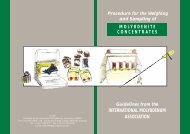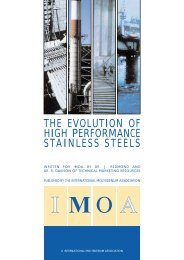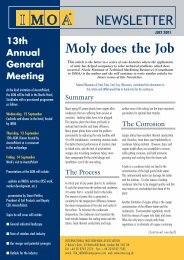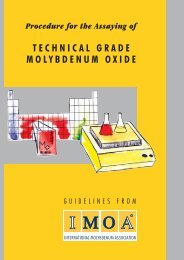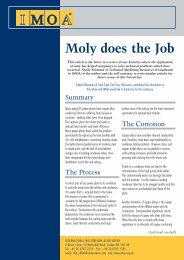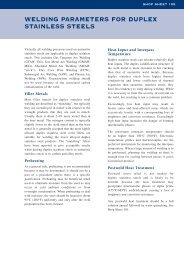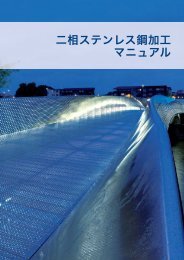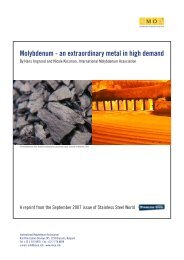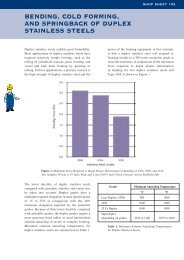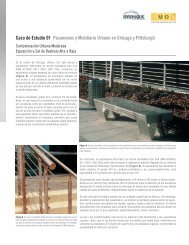2003 - IMOA
2003 - IMOA
2003 - IMOA
You also want an ePaper? Increase the reach of your titles
YUMPU automatically turns print PDFs into web optimized ePapers that Google loves.
Moly Does the Job<br />
This case study has been kindly contributed by Dr Peter Dierschke, Materials<br />
Consultant to the Hempel Special Metals Group,Oberhausen, Germany<br />
(the company may be contacted on info@hempel-metals.com)<br />
Molybdenum Brings Safety into Swimming Pool Buildings<br />
Summary<br />
In 1985 the suspended ceiling of a swimming pool<br />
in Uster, Switzerland crashed down into the pool<br />
and killed 12 bathers. Several years later, in 2001,<br />
a similar accident occurred in The Netherlands –<br />
fortunately in the second case during the night<br />
without casualties. The accidents were found to be<br />
caused by stress corrosion cracking of molybdenumfree<br />
Type 304 stainless steel fasteners and hangers<br />
that carried the weight of the suspended ceiling.<br />
While the standard grade stainless steels like Type<br />
304 and the 2% molybdenum containing Type 316<br />
perform well in many applications in and around<br />
swimming pools, they should not be used for<br />
safety-critical, load-bearing applications. Only<br />
highly corrosion resistant 6% molybdenum-type<br />
stainless steel can resist stress corrosion cracking in<br />
the aggressive environment that can build in spaces<br />
where maintenance cleaning is difficult or<br />
impossible.<br />
The Application<br />
Stainless steels are well established as corrosion<br />
resistant, low maintenance, construction materials<br />
in and around swimming pools. They are found in<br />
the pool water as ladders, stairs, and components of<br />
wave machines, around the pool, for example as<br />
diving boards, and as parts of the building like air<br />
conditioning systems, doors and windows. The<br />
widespread use is due to the good corrosion<br />
resistance, the attractive appearance, the good<br />
workability and an acceptable price. The formation<br />
of a thin but extremely dense oxide layer on the<br />
surface of stainless steels, the passive layer, protects<br />
the steel from corrosion.<br />
Because of their corrosion resistance stainless steels<br />
are also used in structural applications in swimming<br />
pool buildings such as for hangers and fasteners of<br />
components such as suspended ceilings, wall panels<br />
or water piping and air ducts.<br />
The Corrosion<br />
To kill bacteria and viruses introduced by bathers,<br />
disinfecting agents, often chlorine based chemicals,<br />
are introduced to the pool water. The pool water<br />
chemistry is extremely complex: Chlorine reacts with<br />
nitrogenous compounds found in sweat and urine to<br />
form chloramines. The chloramines are highly<br />
volatile and are responsible for the characteristic<br />
"pool smell". Chloramines are, due to their high<br />
volatility, spread in the whole atmosphere of the<br />
pool. They are found to be absorbed into<br />
condensates formed on the surfaces even in the<br />
most remote part of the pool building. Because<br />
these areas are not regularly washed, they can form<br />
an extremely corrosive<br />
electrolyte containing high<br />
amounts of chlorides with low<br />
pH – value over time.<br />
This aggressive electrolyte<br />
turned out to be capable of<br />
causing room temperature<br />
chloride stress corrosion<br />
cracking (CSCC) in Type 304<br />
stainless steel (Figure 1). This<br />
was a surprising finding,<br />
because up to the time of the<br />
first accident, it was believed<br />
that CSCC of this stainless steel<br />
does not occur below<br />
50 to 60 °C (120 – 140 °F).<br />
The Solution<br />
Moly does the job<br />
In the following years many corrosion investigation<br />
programs were carried out on this topic. In several<br />
working programs it was found that the<br />
molybdenum – free type 304 and low molybdenum<br />
type 316 can suffer CSCC under severe pool<br />
conditions. Even the Duplex stainless steel 2205<br />
suffered localized corrosion in these conditions<br />
which can lead to significant reduction of the<br />
strength. Only the 6% - Mo stainless steels showed<br />
sufficient corrosion resistance.<br />
The results of the test programs have found their<br />
way into national building regulations like the<br />
German bauaufsichtliche Zulassung Z-30.3-6 from<br />
1999 "Bauteile und Verbindungselemente aus<br />
nichtrostenden Stählen". Figure 2 shows part of<br />
this regulation wherein four categories of corrosivity,<br />
from low to high, are defined. Category 4 "high" is<br />
used for constructions with high load of chlorides<br />
and other pollutants if concentration of<br />
pollutants can occur because the area cannot<br />
be accessed for cleaning. Under these<br />
conditions the stainless steels 1.4565, 1.4529<br />
and 1.4547 are specified.<br />
As a reaction to these findings, two swimming<br />
pools in The Netherlands recently changed their<br />
under-roof suspensions from galvanised steel to a<br />
6% Molybdenum stainless steel. Figure 3 shows<br />
a fastener made completely out of alloy 926 for<br />
suspension of a ceiling construction.<br />
Figure 1: Part of a suspension made of Type 304 damaged by<br />
Stress corrosion cracking in the atmosphere of a swimming pool.<br />
Acknowledgement<br />
Figure (1) Courtesy of Mr Jan Heselmans, Force Technology b.v., published in"Stainless Steel World" (December 2001).<br />
3



